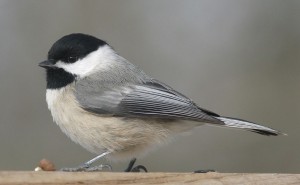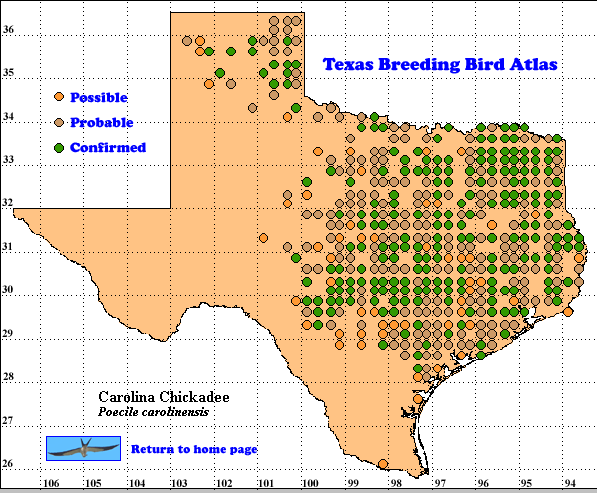The ranges of three closely-related chickadees: Carolina, Black-capped (P. atricapillus) and Mountain (P. gambeli), cover most of the 48 contiguous United States. The most widespread of these, the Black-capped, is only accidental in Texas and the Mountain breeds in this state only in the Davis and Guadalupe mountains of the Trans-Pecos. Carolina Chickadees, in contrast, are widespread in east and central Texas (Lockwood and Freeman 2005).
While Carolina and Black-capped chickadees are similar in appearance, vocal differences are apparent and visual distinction is possible. (Pyle 1997, Mostrom et al. 2002).
DISTRIBUTION. During the 1987-1992 field work of the TBBA project, observers found Carolina Chickadees breeding throughout the Pineywoods and the Post Oak Savannah and Blackland Prairies regions, much of the Rolling Plains and Edwards Plateau and some of the High Plains (see the map of regions in Lockwood and Freeman [2004]). The North American Breeding Bird Survey (BBS) found relative abundances of 10-30 chickadees per 40 km (25 mi) route per year across the first 2 regions, dropping to 3-10 in surrounding regions. One route, Caledonia, in Rusk County, had an annual average count of 47.3 chickadees, the 2nd highest total in the United States (Price et al. 1995, Sauer et al. 2005).
Texas and Oklahoma form the western boundary of the range of this chickadee which resides from the Gulf Coast and central Florida north to New Jersey and the southern portions of Pennsylvania, Ohio, Indiana, Illinois and Missouri and southeastern Kansas (Mostrom et al. 2002, Sauer et al. 2005).
SEASONAL OCCURRENCE. Carolina Chickadees are year-round residents of Texas, breeding from February to July, based on TBBA data . About equal numbers of confirmed records were found in each of the months March to June with very few in February and July.
BREEDING HABITAT. Carolina Chickadees breed in Texas from near sea level to 850 m (2800 ft). In lowlands they are found in swamp forests of oak, black gum. sweetgum, water tupelo and cypress. Other common habitats are marine or riparian hardwood forests of live oak, elm, ash or cottonwood. This species also breeds in a variety of hardwood or pine forests (Oberholser 1974, Mostrom et al. 2002).
The nest is placed in a natural cavity (often near a forest edge), nest box or a hole in a fence post. A base of moss is sometimes overlaid with bark strips and the cup is formed of hair and sometimes plant fibers. The most common clutch size in Texas is 6 (range 3-10) dull white eggs, indistinguishable from those of Black- capped Chickadee. Incubation by the female lasts 12-15 days and young birds leave the nest 16-19 days after hatching. One or occasionally two broods may be raised per season in Texas. Brood parasitism is rare (Harrison 1979, Mostrom et al. 2002, TBBA data).
STATUS. Carolina Chickadee is a common resident of the eastern half of Texas (Lockwood and Freeman 2004). BBS data from 107 routes produced a 95% confidence interval (There is a 95% chance the actual population trend will be between these two numbers.) of -1.7 to +0.5% annual population change for the period 1966-2005 in Texas. This is similar to the statistically significant trends of -0.7% and -1.0% for the whole range of this species for the periods 1966-2005 and 1980-2005, respectively (Sauer et al. 2005). These relatively small changes are encouraging for the future of the Carolina Chickadee in Texas.
Text by Robert C. Tweit (2006)
Literature cited.
Harrison, H. H. 1979. A field guide to western birds’ nests. Houghton Mifflin, Boston, MA.
Lockwood, M. W. and B. Freeman. 2004. The TOS handbook of Texas birds. Texas A&M University Press, College Station.
Mostrom, A. M., R. L. Curry and R. Lohr. 2002. Carolina Chickadee (Poecile carolinensis). In The birds of North America, No. 636 (A. Poole and F. Gill, eds.). The Birds of North America, Inc., Philadelphia, PA.
Oberholser, H. C. 1974. The bird life of Texas. University of Texas Press, Austin.
Price, J., S. Droege, and A. Price. 1995. The summer atlas of North American birds. Academic Press, New York.
Pyle, P. 1997. Identification guide to North American birds, part 1. Slate Creek Press, Bolinas, CA.
Sauer, J. R., J. E. Hines, and J. Fallon. 2005. The North American Breeding Bird Survey, results and analysis 1966-2005. Version 6.2 2006. USGS Patuxent Wildlife Research Center, Laurel MD < http://www.mbr-pwrc.usgs.gov/bbs>

